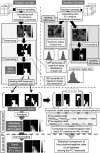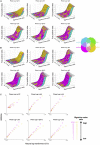Comparison of Phase Synchronization Measures for Identifying Stimulus-Induced Functional Connectivity in Human Magnetoencephalographic and Simulated Data
- PMID: 32636735
- PMCID: PMC7318889
- DOI: 10.3389/fnins.2020.00648
Comparison of Phase Synchronization Measures for Identifying Stimulus-Induced Functional Connectivity in Human Magnetoencephalographic and Simulated Data
Abstract
Phase synchronization measures are widely used for investigating inter-regional functional connectivity (FC) of brain oscillations, but which phase synchronization measure should be chosen for a given experiment remains unclear. Using neuromagnetic brain signals recorded from healthy participants during somatosensory stimuli, we compared the performance of four phase synchronization measures, imaginary part of phase-locking value, imaginary part of coherency (ImCoh), phase lag index and weighted phase lag index (wPLI), for detecting stimulus-induced FCs between the contralateral primary and ipsilateral secondary somatosensory cortices. The analyses revealed that ImCoh exhibited the best performance for detecting stimulus-induced FCs, followed by the wPLI. We found that amplitude weighting, which is related to computing both ImCoh and wPLI, effectively attenuated the influence of noise contamination. A simulation study modeling noise-contaminated periodograms replicated these findings. The present results suggest that the amplitude-dependent measures, ImCoh followed by wPLI, may have the advantage in detecting stimulus-induced FCs.
Keywords: amplitude coherence; cross-periodogram; functional connectivity; phase synchronization; somatosensory system.
Copyright © 2020 Yoshinaga, Matsuhashi, Mima, Fukuyama, Takahashi, Hanakawa and Ikeda.
Figures







Similar articles
-
Benchmarking metrics for inferring functional connectivity from multi-channel EEG and MEG: A simulation study.Chaos. 2020 Dec;30(12):123124. doi: 10.1063/5.0018826. Chaos. 2020. PMID: 33380013
-
Test-Retest Reliability of Magnetoencephalography Resting-State Functional Connectivity in Schizophrenia.Front Psychiatry. 2020 Dec 16;11:551952. doi: 10.3389/fpsyt.2020.551952. eCollection 2020. Front Psychiatry. 2020. PMID: 33391043 Free PMC article.
-
An improved index of phase-synchronization for electrophysiological data in the presence of volume-conduction, noise and sample-size bias.Neuroimage. 2011 Apr 15;55(4):1548-65. doi: 10.1016/j.neuroimage.2011.01.055. Epub 2011 Jan 27. Neuroimage. 2011. PMID: 21276857
-
Cortical oscillatory changes occurring during somatosensory and thermal stimulation.Prog Brain Res. 2006;159:237-52. doi: 10.1016/S0079-6123(06)59016-8. Prog Brain Res. 2006. PMID: 17071235 Review.
-
A Tutorial Review of Functional Connectivity Analysis Methods and Their Interpretational Pitfalls.Front Syst Neurosci. 2016 Jan 8;9:175. doi: 10.3389/fnsys.2015.00175. eCollection 2015. Front Syst Neurosci. 2016. PMID: 26778976 Free PMC article. Review.
Cited by
-
Evaluating the Alterations Induced by Virtual Reality in Cerebral Small-World Networks Using Graph Theory Analysis with Electroencephalography.Brain Sci. 2022 Nov 28;12(12):1630. doi: 10.3390/brainsci12121630. Brain Sci. 2022. PMID: 36552090 Free PMC article.
-
Brain functional connectivity based on phase lag index of electroencephalography for automated diagnosis of schizophrenia using residual neural networks.J Appl Clin Med Phys. 2023 Jul;24(7):e14039. doi: 10.1002/acm2.14039. Epub 2023 Jun 6. J Appl Clin Med Phys. 2023. PMID: 37282716 Free PMC article.
-
How Functional Connectivity Measures Affect the Outcomes of Global Neuronal Network Characteristics in Patients with Schizophrenia Compared to Healthy Controls.Brain Sci. 2023 Jan 13;13(1):138. doi: 10.3390/brainsci13010138. Brain Sci. 2023. PMID: 36672119 Free PMC article.
-
Connectivity Analysis for Multivariate Time Series: Correlation vs. Causality.Entropy (Basel). 2021 Nov 25;23(12):1570. doi: 10.3390/e23121570. Entropy (Basel). 2021. PMID: 34945876 Free PMC article.
-
Classification of internet addiction using machine learning on electroencephalography synchronization and functional connectivity.Psychol Med. 2025 May 16;55:e148. doi: 10.1017/S0033291725001035. Psychol Med. 2025. PMID: 40376927 Free PMC article.
References
-
- Almeida M., Bioucas-Dias J., Vigário R. (2013). Separation of phase-locked sources in pseudo-real MEG data. EURASIP J. Adv. Signal Process. 2013:32 10.1186/1687-6180-2013-32 - DOI
-
- Benjamini Y., Hochberg Y. (1995). Controlling the false discovery rate: a practical and powerful approach to multiple testing. J. R. Stat. Soc. Ser. B 57 289–300. 10.1111/j.2517-6161.1995.tb02031.x - DOI
LinkOut - more resources
Full Text Sources

